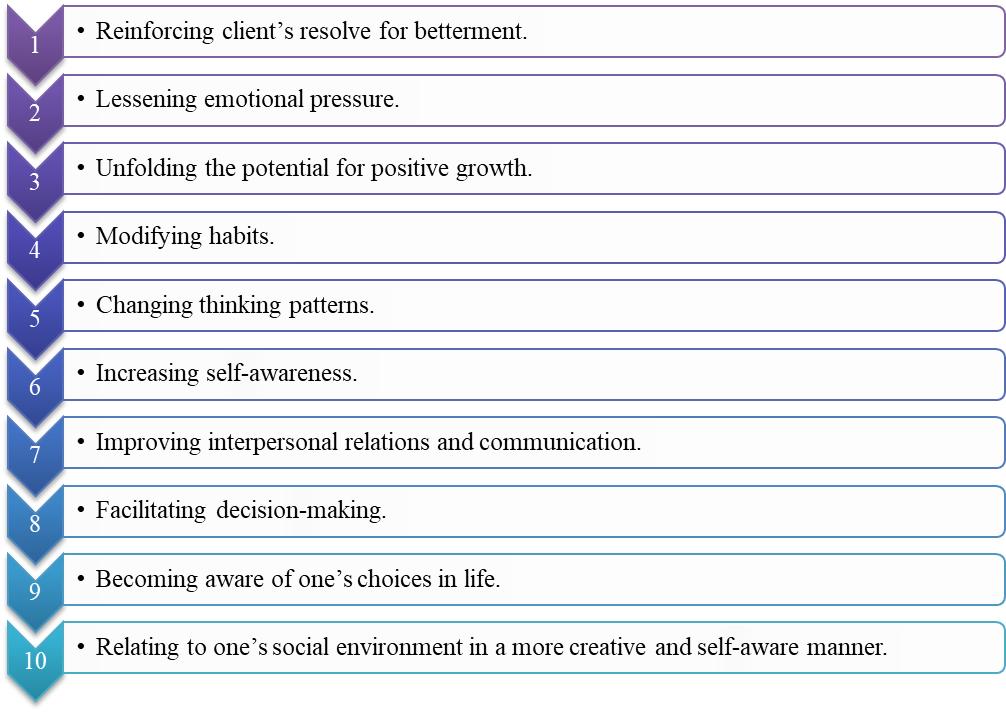- Books Name
- Psychology Book Class-12
- Publication
- PathSet Publications
- Course
- CBSE Class 12
- Subject
- Psychology
Nature and Process of Psychotherapy
- Psychotherapy is a voluntary relationship between the one seeking treatment (client) and the one who treats (therapist).
- The purpose of the relationship is to help the client to solve the psychological problems being faced by her/him.
- The relationship is conducive for building the trust of the client so that problems may be freely discussed.
- Psychotherapies aim at:
- changing the maladaptive behaviours
- decreasing the sense of personal distress
- helping the client to adapt better to her/his environment
- Inadequate marital, occupational and social adjustment also requires that major changes be made in an individual’s personal environment.
- Characteristics of Psychotherapeutic Approaches:
- there is systematic application of principles underlying the different theories of therapy
- persons who have received practical training under expert supervision can practice psychotherapy, and not everybody. An untrained person may unintentionally cause more harm than any good
- the therapeutic situation involves a therapist and a client who seeks and receives help for her/his emotional problems (this person is the focus of attention in the therapeutic process)
- the interaction of these two persons — the therapist and the client — results in the consolidation/formation of the therapeutic relationship. This is a confidential, interpersonal, and dynamic relationship. This human relationship is central to any sort of psychological therapy and is the vehicle for change.
- Goals of Psychotherapy:

- Therapeutic Relationship or Alliance
- The special relationship between the client and the therapist is known as the therapeutic relationship or alliance.
- It is neither a passing acquaintance, nor a permanent and lasting relationship.
- Two major components of a therapeutic alliance are:
- The contractual nature of the relationship in which two willing individuals, the client and the therapist, enter into a partnership which aims at helping the client overcome her/his problems.
- The limited duration of the therapy. This alliance lasts until the client becomes able to deal with her/his problems and take control of her/ his life.
- Several unique properties of the realtionship are:
- It is a trusting and confiding relationship. The high level of trust enables the client to unburden herself/himself to the therapist and confide her/his psychological and personal problems to the latter.
- The therapist encourages this by being accepting, empathic, genuine and warm to the client.
- The therapist conveys by her/his words and behaviours that s/he is not judging the client and will continue to show the same positive feelings towards the client even if the client is rude or confides all the ‘wrong’ things that s/he may have done or thought about. This is the unconditional positive regard which the therapist has for the client (such as acceptance and respect).
- The therapist has empathy for the client. Empathy is different from sympathy and intellectual understanding of another person’s situation.
- In sympathy, one has compassion and pity towards the suffering of another but is not able to feel like the other person.
- Intellectual understanding is cold in the sense that the person is unable to feel like the other person and does not feel sympathy either.
- Empathy is present when one is able to understand the plight of another person, and feel like the other person. It means understanding things from the other person’s perspective, i.e. putting oneself in the other person’s shoes. Empathy enriches the therapeutic relationship and transforms it into a healing relationship.
- The therapeutic alliance requires that the therapist must keep strict confidentiality of the experiences, events, feelings or thoughts disclosed by the client.
- The therapist must not exploit the trust and the confidence of the client in anyway.
- It must remain a professional relationship.

 PathSet Publications
PathSet Publications
